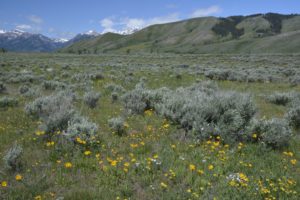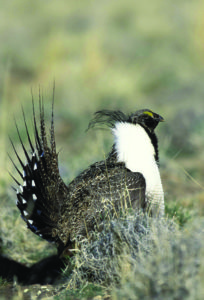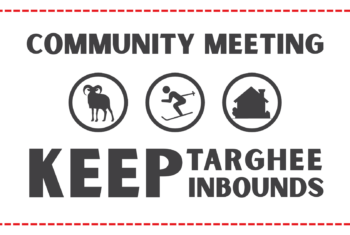Sagebrush & Sage-Grouse
 The sagebrush steppe and grasslands are critical habitats of Jackson Hole, providing habitat for ungulates, carnivores, small mammals, and birds, including the vulnerable greater sage-grouse. The sagebrush steppe habitat is dominated by mountain big sagebrush but includes many other species of shrubs, grasses, and forbs. Agriculture, animal husbandry, and residential development have all impacted the amount of sagebrush habitat available for those species. The Jackson Hole population of greater sage-grouse, genetically distinct from other populations, do not make long-distance migrations but stay in the area year-round.
The sagebrush steppe and grasslands are critical habitats of Jackson Hole, providing habitat for ungulates, carnivores, small mammals, and birds, including the vulnerable greater sage-grouse. The sagebrush steppe habitat is dominated by mountain big sagebrush but includes many other species of shrubs, grasses, and forbs. Agriculture, animal husbandry, and residential development have all impacted the amount of sagebrush habitat available for those species. The Jackson Hole population of greater sage-grouse, genetically distinct from other populations, do not make long-distance migrations but stay in the area year-round.
Sagebrush, a vital connector habitat, now exists in about 55% of its previous extent across the west. In the Greater Yellowstone Ecosystem (GYE) the invasive plant species cheatgrass, aided by the prevalence of fire and human disturbances, rapidly outcompetes sagebrush to dominate the landscape. With fire activity likely to continue increasing as the climate warms, the presence of cheatgrass will make it increasingly more difficult for sagebrush to recolonize.
Sagebrush and Dependent Species
A fire in 2003 burned a significant portion of sage-grouse winter habitat around Blacktail Butte, and in total an estimated 13.5% of available sagebrush in the Upper Snake River Sage-Grouse Conservation Area has burned within the last 30 years.
Entirely dependent on the sagebrush ecosystem, an estimated 50-75% of greater sage-grouse populations have declined since the 1950s, with roughly 45% of their habitat lost in Jackson Hole.
Males on leks, an easy way to estimate populations based on the number of males at courtships areas, have declined from 200 males per year from 1948-1951 to a range of 47 males to 165 males in the last two decades.
The greater sage-grouse, highly sensitive to noise, may also be impacted by increased noise from roadways and air traffic. The Jackson Hole Airport has development a Wildlife Hazard Management Plan to reduce negative effects on grouse, but it may be challenging to fully compensate for in increase in the number of aircraft or potential airport expansion.





